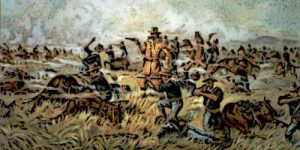Great Sioux War of 1876
Great Sioux War of 1876 Background
In the 1860s, the American government reached an agreement with the Native American Cheyenne and Lakota tribes. According to this agreement, the Native American tribes owned the Black Hills area and white settlers were not allowed to inhabit the region.
But then in 1874, gold was discovered in the Black Hills and thousands of white miners and prospectors started arriving in the region.
The U.S. government tried to stop these white settlers but failed. Then the government tried to buy the Black Hills area from the Native American tribes but they refused to sell their homeland. This finally led to a war with the Native American tribes on one side and the U.S. government on the other side.
Important Commanders on both sides
The Great Sioux War of 1876 comprised a number of battles and minor engagements between the two sides. On the U.S. army’s side, the major commanders involved in these battles included Brigadier General George Crook, Lieutenant Colonel George Armstrong Custer, Colonel Nelson A. Miles, and Wesley Merritt.
Famous Native American warriors and leaders who took a part in this war included Sitting Bull, Crazy Horse, Dull Knife, and Little Wolf.
Major Battles of the Great Sioux War of 1876
The first battle of the war was the Battle of Powder River fought on March 17, 1876. In this battle, a U.S. army attacked a Cheyenne encampment and thus started the Great Sioux War.
In June 1876, another U.S. army under General Crook fought at the Battle of the Rosebud where the Native American tribes were able to stop the advance of the army.
The famous Battle of Little Bighorn took place in June 1876 resulting in a tragic defeat for the U.S. army in which nearly 270 U.S. soldiers died.
Following this defeat, the U.S. government poured more resources into the war effort and the U.S. army soon scored a string of victories against the Native Americans.

Who won the war?
The U.S. government won the war. Although the Native American tribes were defending their own homeland, they didn’t have as many resources and men as the U.S. army. And although the Native American tribes initially scored some victories, they were soon overwhelmed by the U.S. soldiers.
A major problem for the Native American warriors was that the U.S. Army not only fought them but also burnt their villages and encampments, leaving their families homeless.
On the other hand, a large population of the Lakota tribe was already living on Indian reservations and the U.S. government used this population to exert political pressure on the fighting Native Americans.
This ultimately forced the famous Native American warriors such as Sitting Bull and Crazy Horse to surrender and bring the war to an end.
Aftermath
After the Native American leaders surrendered to the U.S. government, the government officially took control of the land previously owned by the Sioux tribe. The government also established permanent Indian reservations where the Native American populations were forced to live.
The war brought an end to the might of the Sioux tribe and ensured that the gold-rich Black Hills area was now in the control of the U.S. government.
Learn More about the Great Sioux War of 1876 at Wikipedia